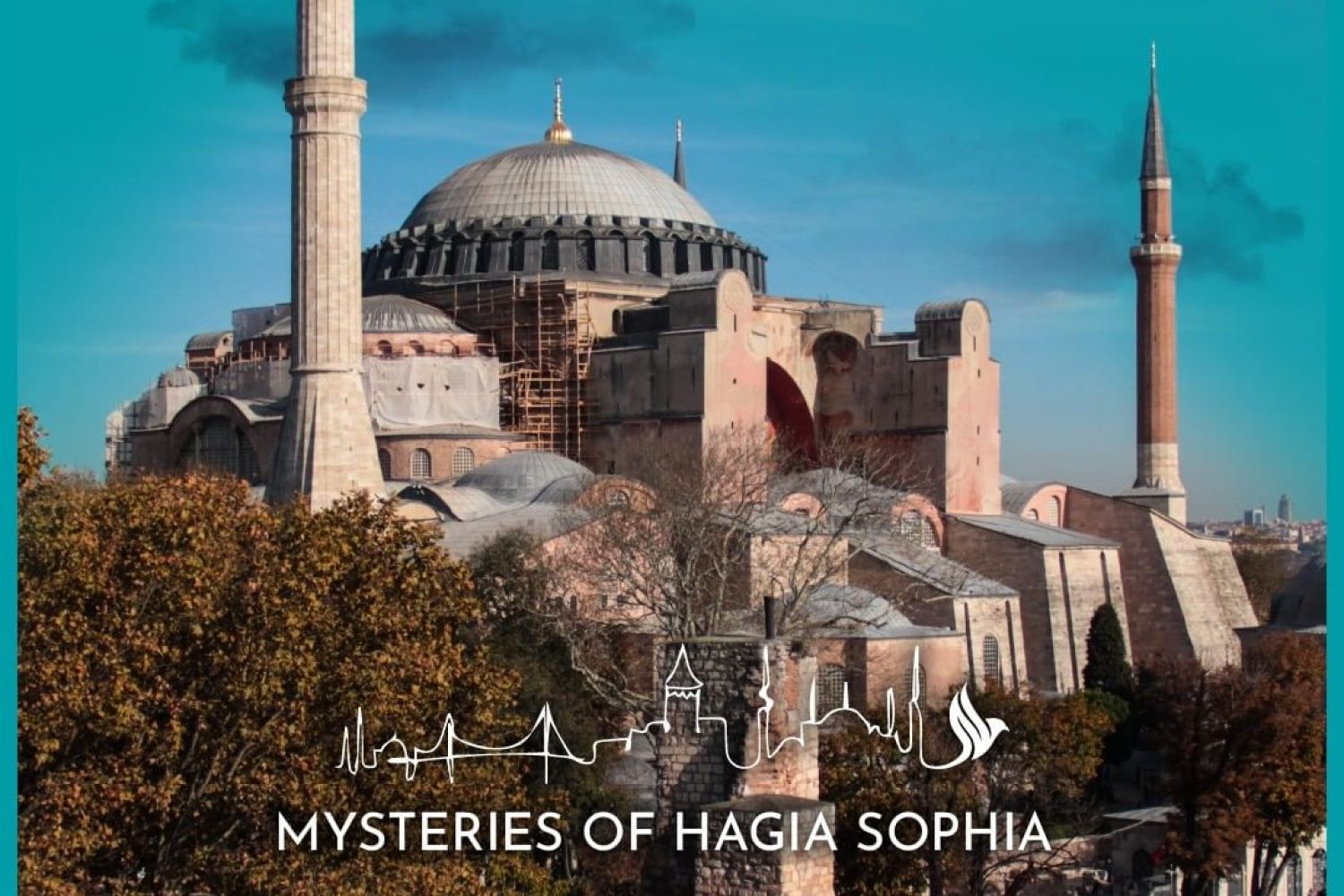After being used as a church for 916 years, a mosque for 482 years and a museum for 85 years since the day it was built for the third time, Hagia Sophia was brought back to the status of a mosque in 2020.
Hagia Sophia is a symbolic structure that contains many mysteries as well as its historical importance and architectural beauty. Legends have been made about it since its inception. There are many legends about Hagia Sophia, including the that giants and jinn took part in its construction, Hızır (Spiritual identity which means Green Man in Arabic) turned Hagia Sophia to the Kaaba, whether the signature in the decision of the Council of Ministers to turn it into a museum belongs to Mustafa Kemal Atatürk.
Hagia Sophia was built by the Byzantine Emperor Justinian between 532-537. Not only its size but also the fact that it was built in such a short time are the reasons why Hagia Sophia is considered as miracle which is the world’s oldest cathedral and the first cathedral built in the shortest time. In addition to these important rational facts, Hagia Sophia also associated with a number of legends.
Let’s take a look at these legends one by one.
- The name Hagia Sophia is a combination of the words “Aya” and “Sofia”. “Aya” means the holy saint and refers to the Virgin Mary. “Sofia” means wisdom in Greek. According to rumors, Justinanus often goes to check the construction during the construction of Hagia Sophia and thinks what the name of this magnificent building will be, but cannot think of anything. In one of these visits, a passerby, impressed by the size of the building, shouts “Aya Sofia” and Justinian hears it. He decides that the name of the cathedral will thus be Hagia Sophia.
- Evliya Çelebi mentions Hz. Hızır as the Architect of Hagia Sophia in his travel book. It is also believed that giants and jinn took part in the construction of Hagia Sophia. Considering the conditions of the time, it is possible to explain the construction of such a structure in five years only with these legends. There are also different rumors about the direction of Hagia Sophia to be turned towards the qibla. According to a rumor, during the first Friday prayer held in Hagia Sophia after Istanbul was conquered, Hz Hızır inserted his finger into the hole in the crying column and turned the direction of the mosque to the qibla, while Fatih Sultan Mehmet took the takbir to lead the prayer.
- It is believed that the cross on which Jesus was crucified and the nails used in this cross are kept in a secret section in Hagia Sophia. According to the belief in Christ, after Jesus was crucified about two thousand years ago and resurrected three days later, he ascended to the sky and will return to the world again. It is believed that when the Prophet Jesus returns to the world, the place he will come to is Hagia Sophia.
- On the day that Istanbul was conquered, the priest who preached in Hagia Sophia disappeared through a door with the holy grail, and the Muslims who wanted to go after him could not proceed because the door turned flat against the wall. According to the belief, if Istanbul is taken back by the Christian World, the priest in question will come back from the same door and continue his sermon from where he left off.
- The people of Istanbul and tourists believe that their wishes will come true when they put their fingers into the pillar, where Hazrat Khidr put his finger into the hole on it and turned the direction of Hagia Sophia to the qibla. So why is there this hole on this column? It is believed that this milk was brought here from the house of the Blessed Virgin Mary, and the hole on her milk was formed by the tears flowing on the column of the Blessed Virgin Mary. When the Blessed Virgin Mary learned that Jesus was captured and tortured, her tears burst into tears, which caused this hole to form on her milk. In addition, this column was believed to be healing because Justinian, who relied on it at the time, had a headache.
- While the construction of the building was going on, solutions were sought for such an imposing structure and its dome to survive under the conditions of the time. The monks suggested that the bones of the past prophets could be placed among the building materials of the dome, so that the dome, which is already very difficult to construct, would be strong. Thereupon, the bones of the prophets from Arab countries were found and brought and placed in the dome.
- It is believed that the 7-meter Emperor’s Gate, one of the hundreds of gigantic gates of the Hagia Sophia Mosque, was built with a piece taken from the ark of Prophet Noah. In this context, it is thought that Emperor Heraclius spent a great deal of effort to find Noah’s ark in the 7th century.
- There are 361 doors in Hagia Sophia, 101 of them are bigger than the others. These doors are believed to be talismanic. Because whenever these doors are tried to be counted, another door always appears.
- In addition, according to Evliya Çelebi’s Travel Book, the corpse of Queen Sofia stands as a mummy in a long chest like a yellow brass metal coffin on the middle qibla door. When many people dared to reach out to this chest, there was a great noise and vibration in the mosque that they had to give up their attempts. This is one great talisman. According to the belief, if this coffin is moved, it is thought that Hagia Sophia will be destroyed. There are 4 angel figures on the dome above the coffin, which is known to belong to Queen Sofia. When the relationship between the figures of Azrael, Israfil, Gabriel and Mikail angels and the coffin was examined, it was thought that Hagia Sophia would be destroyed if the coffin was moved.
- One of the beliefs about Hagia Sophia is that one of the columns writes the date of the apocalypse! Upon entering the door in the south of the building. It is said that Hz. Hızır wrote the date of the end of the world. In the column it is written ‘Sunday, year 1038’.
- If you have been to Hagia Sophia, the fish figures in front of the Emperor’s Gate also have a story. The stories say that the priests in Hagia Sophia were frying fish when Mehmet the Conqueror besieged Istanbul. When the fish fried in the pan realize that Istanbul has been conquered, they come out of the hot oil and turn into stones. In fact, the basis of these fish figures is based on pre-Christian pagan belief.
- Satan is imprisoned in Hagia Sophia: After the conquest of Istanbul by Mehmet the Conqueror, Akşemsettin begins to transform Hagia Sophia into a mosque. In Hagia Sophia, which is trying to be brought up for Friday prayer, despite all efforts, adequate results cannot be achieved, and Akşemseddin realizes that the reason for this is the delusions given to the workers by the devil. Upon this, Akşemseddin’s prayed to God and his prayer was accepted and God imprisoned the devil in a marble in Hagia Sophia.
- The Secret in the Deisis Mosaic: One of the mosaics in Hagia Sophia is the Deisis Mosaic, made in 1264. It is claimed that he is not Jesus on that mosaic. The reason for this is the scar in the form of the number 11 on the right eyebrow of the Jesus figure in the mosaic. It is known that the 11 symbol belongs to Apollon, a member of the Pythagorean Sect. For this reason, although the Pagans, who were forcibly converted to Christianity in their time, seem to make a Jesus figure on the mosaic, it is thought that they actually painted Apollo.
- On the support of one of the domes on the southeast side of Hagia Sophia, there is a trail 6 meters high from the ground. There are various rumors about the mark, which resembles a paw or a large hand. Rumors says that Fatih Sultan Mehmet rested his hand on this column because his horse was afraid and also the movements of the horse gave harm to the column beside.
- VIKING SIGNATURE: “HALVDAN WAS HERE”: About a thousand years ago, Vikings living in northern Europe were known for their desire to explore worlds beyond their shores. A Viking commander who came to visit Istanbul in the 9th century wrote on the marble of Hagia Sophia, “Halvdan was here” in the old Viking language. The mystery of these shapes, which for years was probably perceived as ordinary scratches or marble cracks, has recently been solved.





